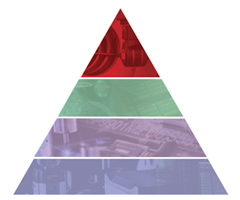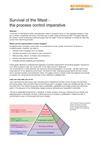加工後モニタリング
計測の全自動化を実現する最新の計測技術。
加工後モニタリング層では、加工工程と完成パーツを検査し、各工程の状態と結果を記録します。加工の完了後に、豊富なデータに基づいて措置を適用する層です。
トレーサブルな手段で規格への準拠を確認

加工工程後のモニタリング層では、加工工程と完成パーツを仕様に対してチェックし、工程の状態と結果を記録します。
加工の完了後に、豊富なデータに基づいて措置を適用する層です。
記録対象
- プロセスのパラメータ、オフセットや座標系に手動または自動で加えた変更など、加工工程中に発生したイベント
- 結果に影響した可能性のある工程への介入
オンマシン寸法計測で実現すること
- 金属切削加工時と同じ環境での重要形状の寸法計測
- 加工工程の安定性の確認
工程後に外部出力することで実現すること
- パーツの規格準拠記録
- 主要形状寸法の履歴取得 (機械状態のモニタリングと定期メンテナンスのため)
豊富なデータに基づく制御
最新計測技術を活用することで、非常に複雑なパーツでも、多くの場合 1 回の段取りで完全に自動で計測できます。熟練した検査担当者が品質保証のためのチェックを管理する必要性が低減します。
最新の 5 軸技術を活用することで三次元測定機でのパーツ測定にかかる時間を 3 分の 1 に短縮できます。汎用性に優れたゲージングシステムにより、量産/中量産パーツの高速検査が可能になり、プロセスフィードバックを取得できます。
オンマシン寸法計測を行うことで、段取り状態が悪化する前に規格外の部品を検出できるためその場で修正作業を実施できます。
レニショーの REVO®、PH20、Equator™ は、パーツの仕様準拠に関するトレーサブルで迅速なレポート作成と切削作業の状態と結果の記録に不可欠なツールです。
資料
-
 カタログ: パンフレット: 生産効率を向上させるための計測ソリューション
カタログ: パンフレット: 生産効率を向上させるための計測ソリューション
プロセス制御のエキスパート企業が、貴社の生産工程のパフォーマンス変革をお手伝いします
-
 White paper: Survival of the fittest - the process control imperative [en]
White paper: Survival of the fittest - the process control imperative [en]
In tough times, manufacturers focus on reducing their operating costs, but may not be able to afford to spend their way out by buying more productive machinery. With that pathway closed, what are the opportunities for radically reducing costs without replacing existing machines? This paper explores four areas where substantial savings can be found if firms are prepared to change the way they control their machining processes.

